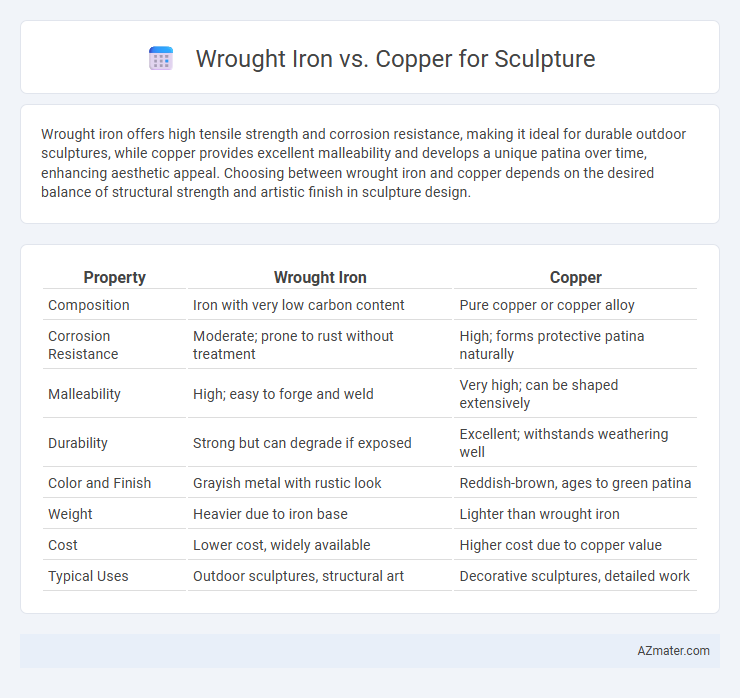Wrought iron offers high tensile strength and corrosion resistance, making it ideal for durable outdoor sculptures, while copper provides excellent malleability and develops a unique patina over time, enhancing aesthetic appeal. Choosing between wrought iron and copper depends on the desired balance of structural strength and artistic finish in sculpture design.
Table of Comparison
| Property | Wrought Iron | Copper |
|---|---|---|
| Composition | Iron with very low carbon content | Pure copper or copper alloy |
| Corrosion Resistance | Moderate; prone to rust without treatment | High; forms protective patina naturally |
| Malleability | High; easy to forge and weld | Very high; can be shaped extensively |
| Durability | Strong but can degrade if exposed | Excellent; withstands weathering well |
| Color and Finish | Grayish metal with rustic look | Reddish-brown, ages to green patina |
| Weight | Heavier due to iron base | Lighter than wrought iron |
| Cost | Lower cost, widely available | Higher cost due to copper value |
| Typical Uses | Outdoor sculptures, structural art | Decorative sculptures, detailed work |
Introduction: Choosing Materials for Sculpture
Wrought iron offers exceptional durability and a classic rustic aesthetic, making it ideal for outdoor sculptures exposed to the elements. Copper provides a unique, warm patina that evolves over time, contributing to dynamic visual appeal and corrosion resistance. Selecting between wrought iron and copper depends on desired texture, longevity, and environmental conditions for the sculpture.
Overview of Wrought Iron in Sculpture
Wrought iron in sculpture offers exceptional malleability and durability, making it ideal for intricate, large-scale outdoor artworks. Its corrosion resistance improves with proper maintenance, ensuring longevity and structural integrity. Artists value wrought iron for its ability to be welded, forged, and twisted, enabling dynamic and detailed designs.
Overview of Copper in Sculpture
Copper in sculpture offers exceptional malleability and corrosion resistance, making it ideal for intricate and enduring artworks. Its natural reddish-brown patina develops over time, enhancing the sculpture's aesthetic appeal and protecting the surface from environmental damage. Renowned for conductivity and versatility, copper allows sculptors to achieve fine details and dynamic forms unattainable with wrought iron.
Aesthetic Qualities: Wrought Iron vs Copper
Wrought iron sculptures exhibit a robust, rustic aesthetic with a dark, matte finish that emphasizes texture and intricate craftsmanship, making them ideal for bold, industrial designs. Copper sculptures offer a warm, rich luster with a natural ability to develop an elegant green patina over time, enhancing their classical and organic appeal. The choice between wrought iron and copper ultimately depends on the desired visual impact, with wrought iron favoring durability and ruggedness, while copper provides vibrant color shifts and artistic sophistication.
Durability and Longevity Comparison
Wrought iron offers exceptional durability due to its high tensile strength and resistance to deformation, making it suitable for sculptures exposed to mechanical stress and harsh weather conditions. Copper demonstrates superior longevity through its natural patina, which forms a protective oxide layer that prevents corrosion and enhances aesthetic appeal over time. While wrought iron may require regular maintenance to prevent rust, copper sculptures generally endure longer with minimal upkeep in outdoor environments.
Workability and Sculpting Techniques
Wrought iron offers high malleability and tensile strength, enabling detailed hammering, bending, and welding techniques ideal for robust, intricate sculptures. Copper features superior ductility and thermal conductivity, allowing for fine chasing, repousse, and soldering methods that produce smooth, delicate forms with a warm patina. Both metals require specialized tools, but copper's softness facilitates easier shaping, while wrought iron demands more forceful manipulation, influencing the sculptor's choice based on artistic intent.
Cost and Availability Analysis
Wrought iron is generally more cost-effective and widely available due to its abundance and ease of fabrication, making it a preferred choice for large-scale sculptures with budget constraints. Copper, although more expensive, offers superior malleability and corrosion resistance, often justifying its higher price for detail-intensive or outdoor sculptures. Availability of copper may be limited by market fluctuations and sourcing challenges, impacting overall project costs and timelines.
Environmental Impact and Sustainability
Wrought iron and copper differ significantly in environmental impact and sustainability when used for sculpture. Wrought iron is highly recyclable and requires less energy to produce, contributing to lower carbon emissions compared to copper, which involves more intensive mining and refining processes that can result in habitat disruption and higher pollution levels. While copper offers excellent durability and corrosion resistance, its extraction is more environmentally taxing, making wrought iron a more sustainable choice for eco-conscious sculptors.
Maintenance and Care for Both Metals
Wrought iron sculptures require regular maintenance to prevent rust, including periodic cleaning, rust removal, and protective coatings such as paint or wax. Copper sculptures develop a natural patina over time, which acts as a protective layer, but may need occasional cleaning to preserve the desired aesthetic and prevent corrosion in acidic environments. Both metals benefit from sheltered placement and routine inspections to address any signs of wear or environmental damage promptly.
Conclusion: Selecting the Best Metal for Sculpture
Wrought iron offers durability and ease of welding, making it ideal for large, outdoor sculptures requiring structural strength and weather resistance. Copper provides exceptional malleability and develops a natural patina over time, enhancing aesthetic appeal for intricate or decorative pieces. Choosing between wrought iron and copper depends on the sculpture's intended environment, design complexity, and desired longevity.

Infographic: Wrought iron vs Copper for Sculpture
 azmater.com
azmater.com